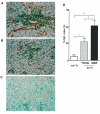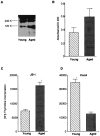Severe destructive autoimmune lesions with aging in murine Sjögren's syndrome through Fas-mediated apoptosis
- PMID: 10793067
- PMCID: PMC1876931
- DOI: 10.1016/S0002-9440(10)65027-4
Severe destructive autoimmune lesions with aging in murine Sjögren's syndrome through Fas-mediated apoptosis
Abstract
When we evaluated the age-associated changes in autoimmune exocrinopathy in a NFS/sld murine model for primary Sjögren's syndrome (SS), severe destructive autoimmune lesions developed in the salivary and lacrimal glands in the aged mice, compared with those observed in the younger model. We detected a decreased secretion of saliva and tear flow in the aged group. A significant increase of TUNEL(+)-apoptotic epithelial duct cells in the salivary glands was detected in the aged SS animal model. A higher proportion of mouse salivary gland cells bearing Fas was found in the aged group, whereas no significant changes were seen on tissue-infiltrating CD4(+) T cells bearing FasL in the salivary glands from young and aged mice. We detected an increased cleavage product of organ-specific autoantigen, 120-kd alpha-fodrin, in the aged salivary gland tissues on immunoblotting, and an increase in serum autoantibody production against 120-kd alpha-fodrin by enzyme-linked immunosorbent assay. An increase in the proliferative response of splenic T cells against organ-specific autoantigen was observed, whereas nonspecific concanavalin A responsiveness was decreased in the aged mice. In addition, a decrease in Fas expression was found on splenic CD4(+) T cells in the aged mice, and anti-Fas mAb-stimulated apoptosis was down-regulated on CD4(+) T cells. These results indicate that age-associated dysregulation of CD4(+) T cells may play a crucial role on acceleration of organ-specific autoimmune lesions in a murine model for primary SS through Fas-mediated apoptosis.
Figures







Similar articles
-
Estrogen deficiency accelerates autoimmune exocrinopathy in murine Sjögren's syndrome through fas-mediated apoptosis.Am J Pathol. 1999 Jul;155(1):173-81. doi: 10.1016/S0002-9440(10)65111-5. Am J Pathol. 1999. PMID: 10393849 Free PMC article.
-
The role of caspase cascade on the development of primary Sjögren's syndrome.J Med Invest. 2003 Feb;50(1-2):32-8. J Med Invest. 2003. PMID: 12630566 Review.
-
Development of autoimmune arthritis with aging via bystander T cell activation in the mouse model of Sjögren's syndrome.Arthritis Rheum. 2004 Dec;50(12):3974-84. doi: 10.1002/art.20679. Arthritis Rheum. 2004. PMID: 15593201
-
Novel role of CD40 in Fas-dependent apoptosis of cultured salivary epithelial cells from patients with Sjögren's syndrome.Arthritis Rheum. 2005 Feb;52(2):573-81. doi: 10.1002/art.20789. Arthritis Rheum. 2005. PMID: 15692983
-
Involvement of apoptotic protease cascade for tissue destruction in Sjögren's syndrome.Arch Immunol Ther Exp (Warsz). 2000;48(5):399-403. Arch Immunol Ther Exp (Warsz). 2000. PMID: 11140467 Review.
Cited by
-
Recent Advances in Mouse Models of Sjögren's Syndrome.Front Immunol. 2020 Jun 30;11:1158. doi: 10.3389/fimmu.2020.01158. eCollection 2020. Front Immunol. 2020. PMID: 32695097 Free PMC article. Review.
-
Dual Role of Fas/FasL-Mediated Signal in Peripheral Immune Tolerance.Front Immunol. 2017 Apr 5;8:403. doi: 10.3389/fimmu.2017.00403. eCollection 2017. Front Immunol. 2017. PMID: 28424702 Free PMC article. Review.
-
Lessons from Animal Models in Sjögren's Syndrome.Int J Mol Sci. 2023 Aug 20;24(16):12995. doi: 10.3390/ijms241612995. Int J Mol Sci. 2023. PMID: 37629175 Free PMC article. Review.
-
Maintenance of immune tolerance to a neo-self acetylcholine receptor antigen with aging: implications for late-onset autoimmunity.J Immunol. 2010 Jun 1;184(11):6067-75. doi: 10.4049/jimmunol.0901618. Epub 2010 Apr 30. J Immunol. 2010. PMID: 20435934 Free PMC article.
-
Unraveling the pathophysiology of Sjogren syndrome-associated dry eye disease.Ocul Surf. 2009 Jan;7(1):11-27. doi: 10.1016/s1542-0124(12)70289-6. Ocul Surf. 2009. PMID: 19214349 Free PMC article. Review.
References
-
- Miller RA: The aging immune system: primers and prospectus. Science 1996, 273:70-74 - PubMed
-
- Pawelec G, Adibadeh M, Pohla H, Schaudt K: Immunosenescence: aging of the immune system. Immunol Today 1995, 16:420-422 - PubMed
-
- Nagel JE, Chopra RK, Chrest FJ, McCoy MT, Schneider EL, Holbrook NJ, Adler WH: Decreased proliferation, interleukin 2 synthesis, and interleukin 2 receptor expression are accompanied by decreased mRNA expression in phytohemagglutinin-stimulated cells from elderly donors. J Clin Invest 1988, 81:1096-1102 - PMC - PubMed
-
- Proust JJ, Filburn CR, Harrison SA, Buchholz MA, Nordin AA: Age-related defect in signal transduction during lectin activation of murine T lymphocytes. J Immunol 1987, 139:1472-1478 - PubMed
Publication types
MeSH terms
Substances
LinkOut - more resources
Full Text Sources
Other Literature Sources
Medical
Molecular Biology Databases
Research Materials
Miscellaneous

